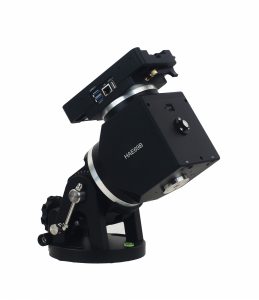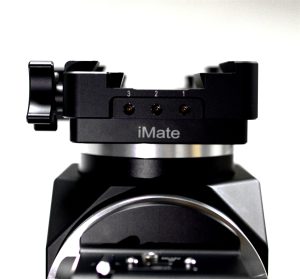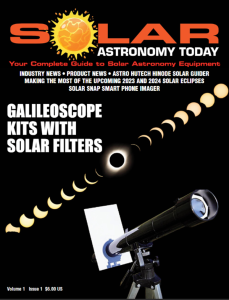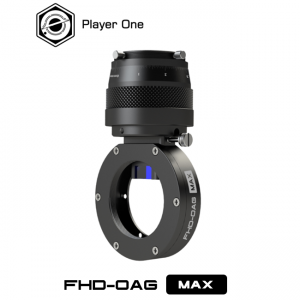Keeping pace with the current rapidly developing technology environment, the iOptron HAE69 and HAE69EC SWG mounts have evolved into the iOptron HAE69B iMate.
 As the iOptron team notes, “These lightweight, compact, medium payload titans will deliver an astronomy experience like never before. Imagine a mount head weighing in at less than 20 lbs. with a payload capability of 69 lbs., without needing a cumbersome counterweight or shaft. Applying iOptron’s multi-decade experience creating precision mounts, the HAE69 makes this vision possible.”
As the iOptron team notes, “These lightweight, compact, medium payload titans will deliver an astronomy experience like never before. Imagine a mount head weighing in at less than 20 lbs. with a payload capability of 69 lbs., without needing a cumbersome counterweight or shaft. Applying iOptron’s multi-decade experience creating precision mounts, the HAE69 makes this vision possible.”
Utilizing state-of-the-art strain wave gear technology for both RA and DEC movement, the iOptron HAE69B iMate delivers unparalleled weight to payload efficiency. Its black anodized, all metal CNC machined body is appealing to the eye and is a rugged platform that will perform at the highest level for many years to come. Unique features such as an electronic friction brake and power-down memory allow the mount to safely stop and resume a GoTo slew or continue tracking even after an abrupt power loss with no need to realign and start from the beginning.
The iMate models feature a powerful 64-bit ARM based on-board computer with Wi-Fi, preloaded KStars planetarium software, Ekos control and automation tool and INDI drivers. This hardware-software combination will support the use of most current and future devices (cameras, focusers, filter wheels, etc.) allowing the user a broad choice of brands and models.
With 32Gb eMMC storage along with a slot for an up to 64Gb TF (micro-SD) memory, the iMate has the ability to control and capture an entire automated imaging session. The iMate is cross-platform and can be used with Windows, MacOS, Linux, iOS and Android and other platforms.
 The iOptron HAE69B iMate dual SWG Alt-Az/Eq mounts now have an internal main board and no longer requires use with a handset. All the accessories can be connected to the iMate and there are no cable drag when the mount is operating. The HAE69BEC features a high precision RA axis encoder that delivers incredible tracking accuracy, enough that many will choose to image “sans” guiding.
The iOptron HAE69B iMate dual SWG Alt-Az/Eq mounts now have an internal main board and no longer requires use with a handset. All the accessories can be connected to the iMate and there are no cable drag when the mount is operating. The HAE69BEC features a high precision RA axis encoder that delivers incredible tracking accuracy, enough that many will choose to image “sans” guiding.
iOptron HAE69B iMate specifications and features include:
– Advanced strain wave gear system technology
– Payload capacity of 31 kg (69 lbs.) with the mount weight of 8.6 kg (19 lbs., include dovetail saddle)
– PE< ± 15 arcsec
– CNC machined
– Unique friction brake to safely stop movement during a planned or unplanned power interruption
– 270 second gear period
– Built-in, open-source iMate computer with Wi-Fi, preloaded KStarts/Ekos/INDI driver and iPolarServer
– iMate with 3X 12V DC outputs, 2X USB2.0 and 1X USB3.0 ports
– No cable drags
– Go2Nova handset with OLED for better user experiences, especially at extreme temperatures
– iPolar electronic polar scope for easy and accurate polar alignment (Optional)
– Dual saddle (Vixen and Losmandy-D styles)
– Zero position search and locator
– Power down position and location memory
– Integrated ST-4 autoguiding port
– USB port for firmware upgrade and computer control
– Aluminum carrying case
You can learn more about the iOptron HAE69B iMate here.

 And to make it easier for you to get the most extensive news, articles and reviews that are only available in the magazine pages of Astronomy Technology Today, we are offering a 1-year magazine subscription for only $6! Or, for an even better deal, we are offering 2 years for only $9. Click here to get these deals which only will be available for a very limited time. You can also check out a free sample issue here.
And to make it easier for you to get the most extensive news, articles and reviews that are only available in the magazine pages of Astronomy Technology Today, we are offering a 1-year magazine subscription for only $6! Or, for an even better deal, we are offering 2 years for only $9. Click here to get these deals which only will be available for a very limited time. You can also check out a free sample issue here.
The Sun is more active than it’s been in years and if that’s not enough, we have the Annular Solar Eclipse on October 14, 2023 and the Total Solar Eclipse on April 8, 2024! If you’d like to learn more about the technology behind solar observing, solar imaging and more, you can check out our new monthly magazine – Solar Astronomy Today. It’s free to read, no subscription needed and available here. And if you are preparing for the upcoming eclipses and want to know your equipment options from solar glasses to the most out of this world solar viewing and imaging options, check out our free publication – The Definitive Guide to Viewing and Imaging the Sun – simply click here and enjoy reading!



